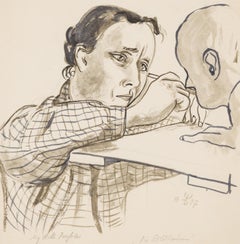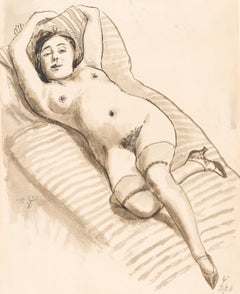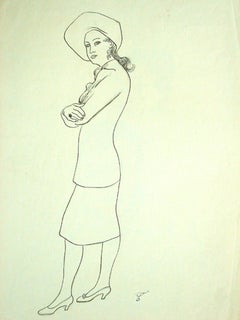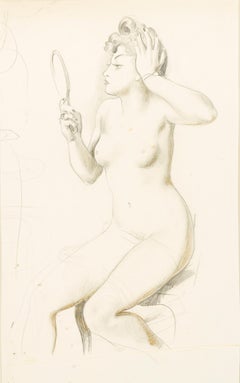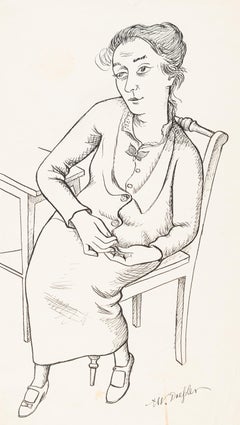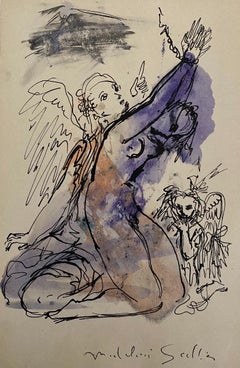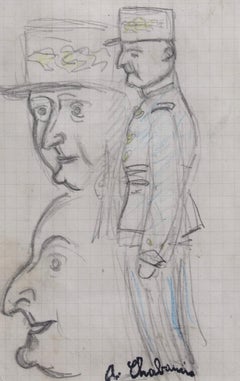August Wilhelm Dressler Portrait Drawings and Watercolors
German, 1886-1970
Wilhelm August Dressler is one of the painters of the New Objectivity (...) and was committed to social and political issues. The Berliner-of-choice defied stubbornly the summary classification. Dressler acted truthfully to his origin, temperament and insight as an individual who presents his bond as obligation, who takes his program as template and his slogan as abomination. Only few painters of his generation restrain so inconspicuously from the revolutionary storm and new trends that found its most effective expression in Expressionism of ” the Bridge” group and in the mystical works of the ‘Blue Rider’. Dressler’s self-imposed isolation is based neither on his capriciousness nor is it intentional – it is simply one of the inner necessities of his artistic existence.
One does not do justice to his work, if one tries to interpret only the visible facts, the artistic or the technical qualities in Dressler’s works. This painter lived his destiny with a stubbornly determined consequence of his fate: the pictures are nothing else than the graphic metaphors of the ‘introverted gaze’. He experienced grief and loneliness already during his youth. Dressler learns early about the shadow side of human existence – it becomes the basis of the way he perceived the world. ” I cannot separate myself from what has established me ” – there was a very immediate connection and solidarity between the painter and his personal experiences (l’art pour l’art attitude). Thus Dressler identifies himself with those embodiments of petty-bourgeois narrowness, with those disappointed and abandoned, with those who appreciate simple joys of life and those with quiet hopes. In his works the figurative language wins through its ability to depict and objectify feelings without words. Dressler does not paint to be modern or original. His way of perception is essential in a solid sense; he focuses on things, elements, and events that reflect a piece of life.
The closeness to the object and the attachment to the figure remain unchanged in Dressler’s oeuvre. One is tempted, looking at his works of five decades, to speak rather than about development but more of unfolding. The thematic inventory is from the beginning artist’s credo and basic motive: the form is added as the answer of the painter. It is Dressler’s personal preference not to correct reality nor to imitate it – his realism brings form and content, sensation and insight to life in a forceless manner.
Dressler feels, thinks and arguments his works on a more general level; his work is not an illustration of social misery or individual depravity. This “realist of the sharper tone” painterly transcends the limitations of genre and folklore; his “petty-bourgeois everyday life” is neither enclosed in the poor man’s pathos nor in the oh-human ecstasy. “Who controls the keyboard of nature”, proclaims Dressler, “can play in their own ways”.
Source: Delp’sche Verlagsbuchhandlung München, August Willhelm Dressler, Munich 1970.to
2
3
Overall Width
to
Overall Height
to
5
1
5
5
5
5
5
3
2
2
2
1
1
4
3
2
1
1
11
189
72
60
51
5
Artist: August Wilhelm Dressler
Die Bildhauerin
By August Wilhelm Dressler
Located in Wien, 9
August Dressler is one of the painters of the New Objectivity. He is one of the lesser-known artists of the Weimar era, but he too, like his famous contemporaries Georg Grosz, John H...
Category
20th Century Modern August Wilhelm Dressler Portrait Drawings and Watercolors
Materials
Paper, Ink
Akt mit Strümpfen
By August Wilhelm Dressler
Located in Wien, 9
August Dressler is one of the painters of the New Objectivity. He is one of the lesser-known artists of the Weimar era, but he too, like his famous contemporaries Georg Grosz, John H...
Category
1920s Modern August Wilhelm Dressler Portrait Drawings and Watercolors
Materials
Ink, Watercolor
Dame mit Hut
By August Wilhelm Dressler
Located in Wien, 9
August Dressler is one of the painters of the New Objectivity. He is one of the lesser-known artists of the Weimar era, but he too, like his famous contemporaries Georg Grosz, John H...
Category
20th Century Modern August Wilhelm Dressler Portrait Drawings and Watercolors
Materials
Paper, Pencil
Akt mit Handspiegel
By August Wilhelm Dressler
Located in Wien, 9
August Dressler is one of the painters of the New Objectivity. He is one of the lesser-known artists of the Weimar era, but he too, like his famous contemporaries Georg Grosz, John H...
Category
20th Century Modern August Wilhelm Dressler Portrait Drawings and Watercolors
Materials
Paper, Pencil
Frau bei Tisch sitzend
By August Wilhelm Dressler
Located in Wien, 9
August Dressler is one of the painters of the New Objectivity. He is one of the lesser-known artists of the Weimar era, but he too, like his famous contemporaries Georg Grosz, John H...
Category
20th Century Modern August Wilhelm Dressler Portrait Drawings and Watercolors
Materials
Paper, Ink
Related Items
The Angels - Original China Ink and Watercolor by Madeleine Scellier - 1955
By Madeleine Scellier
Located in Roma, IT
The Angels is an original drawing in watercolored china ink on ivory-colored paper realized by the French artist Madeleine Scellier (1928).
Hand-signed in pencil on the lower margin...
Category
1950s Modern August Wilhelm Dressler Portrait Drawings and Watercolors
Materials
Paper, Ink, Watercolor
$533
H 9.45 in W 6.3 in D 0.04 in
Mon Colonel
By Auguste Chabaud
Located in London, GB
'Mon Colonel', pencil and crayon on paper, by noted French artist, Auguste Chabaud (circa 1914-1918). A delightfully simple drawing of a French Army colonel in profile along with clo...
Category
1910s Modern August Wilhelm Dressler Portrait Drawings and Watercolors
Materials
Paper, Crayon, Pencil
Female Face - Drawing by Henri Epstein - Early 20th Century
Located in Roma, IT
Female Face is an Pencil Drawing realized by Henri Epstein (1892-1944).
Good condition on a yellowed paper, included a white cardboard (50x35 cm).
Hand-signed by the artist on the lower right corner.
Henri Epstein born in Lódz ( Russian Empire ) on January 14 , 1891 where theJune 20 , 18922 , 3 and died in deportation to Auschwitz ( Third Reich...
Category
Early 20th Century Modern August Wilhelm Dressler Portrait Drawings and Watercolors
Materials
Paper, Pencil
$450
H 12.21 in W 9.06 in D 0.04 in
Portrait of a Young Woman - 1900s - René François Xavier Prinet - Drawing
By René Francois Xavier Prinet
Located in Roma, IT
Portrait of A Young Woman is an original artwork realized by the French artist and illustrator René François Xavier Prinet between the end of the XIX and the beginning of the XX cent...
Category
Early 1900s Modern August Wilhelm Dressler Portrait Drawings and Watercolors
Materials
Paper, Pencil
René Francois Xavier PrinetPortrait of a Young Woman - 1900s - René François Xavier Prinet - Drawing
$237
H 12.6 in W 9.45 in D 0.08 in
The Parade of Fairground Wrestlers, Modern French School
Located in London, GB
'The Parade of Fairground Wrestlers', India ink on art paper, Modern French School (early 1900s). Traveling shows often held promotional events before opening in local areas to generate enthusiasm for the spectacle. This is an intriguing depiction of the various acts on stage strutting their stuff before an audience of potential customers. On the platform, fairground wrestlers mix with clowns, dancers, a percussionist in bolero hat...
Category
Early 20th Century Modern August Wilhelm Dressler Portrait Drawings and Watercolors
Materials
Paper, India Ink
$749
H 14.18 in W 14.18 in
Les Croates (French Army in 1812-13)- Original Drawing By Herbert Knotel - 1940s
Located in Roma, IT
Les Croates is an original drawing in ink and watercolor realized by Herbert Knotel in 1930/40s.
Good condition except for being aged.
The artwork is depicted through strong lines ...
Category
1940s Modern August Wilhelm Dressler Portrait Drawings and Watercolors
Materials
Ink, Watercolor
$414
H 10.24 in W 6.3 in D 0.08 in
Mother and Child - Drawing by Mino Maccari - Mid 20th Century
By Mino Maccari
Located in Roma, IT
Mother and Child is an original China Ink Drawing realized by Mino Maccari in mid-20th Century.
Good condition on a yellowed paper, some sketches on the back.
Hand-signed by the ar...
Category
Mid-20th Century Modern August Wilhelm Dressler Portrait Drawings and Watercolors
Materials
Paper, Ink
$948
H 9.06 in W 12.21 in D 0.04 in
Portrait - Drawing by Joseph Alexander Colin - Mid-20th Century
Located in Roma, IT
Portrait is a drawing realized by Joseph Colin in the Mid-20th Century.
Pencil on ivory-colored paper
Good conditions with slight foxing.
The artwork is realized through deft expr...
Category
Mid-20th Century Modern August Wilhelm Dressler Portrait Drawings and Watercolors
Materials
Pencil, Paper
$284
H 8.27 in W 5.52 in D 0.04 in
M.me Lepic - Original Ink by Chas Laborde - Early 20th Century
By Chas Laborde
Located in Roma, IT
M.me Lepic is an original drawing in China ink with gray tip on ivory paper, realized by Chas Laborde (1886-1941).
Good conditions except for minor cosmetic wear.
Unsigned. Titled on the bottom center. Noted "bag".
Chas Laborde, born in 1886, of Béarnese origin, he was at the same time a reporter, painter, engraver, humorous draftsman, book illustrator and poet.
He was one of the great artists of the early 20th century. He was open to the world and to life. Colette says of him, after having illustrated "Claudine", "He made twenty of these villages bloom, with their colors of a fresh green, of a tulle rose. One has its bell tower, the others who a train, some a row of pioffi, some a house, some a group of...
Category
Early 20th Century Modern August Wilhelm Dressler Portrait Drawings and Watercolors
Materials
Paper, Ink
$474
H 7.76 in W 7.37 in D 0.04 in
Le Croates en Allemagne (French Army)-Original Drawing By Herbert Knotel - 1940s
Located in Roma, IT
Le Croates en Allemagne is an original drawing in ink and watercolor realized by Herbert Knotel in 1930/40s.
Good condition except for being aged.
The artwork is depicted through strong lines in well-balanced conditions.
Herbert Knotel was a german artist, son and pupil of the famous uniformologist and military historian Richard Knotel.
He served as officer under Marshal Hindenburg in the Prussian Army...
Category
1940s Modern August Wilhelm Dressler Portrait Drawings and Watercolors
Materials
Ink, Watercolor
$533
H 10.24 in W 6.3 in D 0.08 in
Le Croates - Original Drawing By Herbert Knotel - 1940s
Located in Roma, IT
Le Croates is an original drawing in ink and watercolor realized by Herbert Knotel in 1930/40s.
Good condition except for being aged.
The artwork is depicted through strong lines i...
Category
1940s Modern August Wilhelm Dressler Portrait Drawings and Watercolors
Materials
Ink, Watercolor
$533
H 10.24 in W 6.3 in D 0.08 in
Big Canvas Apron - Original Ink by Chas Laborde - Early 20th Century
By Chas Laborde
Located in Roma, IT
Big Canvas Apron is an original drawing in China ink with gray tip on ivory paper, realized by Chas Laborde (1886-1941).
Good conditions except for minor cosmetic wear.
Unsigned. Noted "tablier grosse toile".
Chas Laborde, born in 1886, of Béarnese origin, he was at the same time a reporter, painter, engraver, humorous draftsman, book illustrator and poet.
He was one of the great artists of the early 20th century. He was open to the world and to life. Colette says of him, after having illustrated "Claudine", "He made twenty of these villages bloom, with their colors of a fresh green, of a tulle rose. One has its bell tower, the others who a train, some a row of pioffi, some a house, some a group of girls...
Category
Early 20th Century Modern August Wilhelm Dressler Portrait Drawings and Watercolors
Materials
Paper, Ink
Chas LabordeBig Canvas Apron - Original Ink by Chas Laborde - Early 20th Century, Early 20th Century
$260
H 6.5 in W 7.09 in D 0.04 in
August Wilhelm Dressler portrait drawings and watercolors for sale on 1stDibs.
Find a wide variety of authentic August Wilhelm Dressler portrait drawings and watercolors available for sale on 1stDibs. You can also browse by medium to find art by August Wilhelm Dressler in ink, paper, paint and more. Much of the original work by this artist or collective was created during the 20th century and is mostly associated with the modern style. Not every interior allows for large August Wilhelm Dressler portrait drawings and watercolors, so small editions measuring 11 inches across are available. Customers who are interested in this artist might also find the work of Sunil Das, Alfred Bendiner, and Raymond Debieve. August Wilhelm Dressler portrait drawings and watercolors prices can differ depending upon medium, time period and other attributes. On 1stDibs, the price for these items starts at $700 and tops out at $2,779, while the average work can sell for $1,695.
